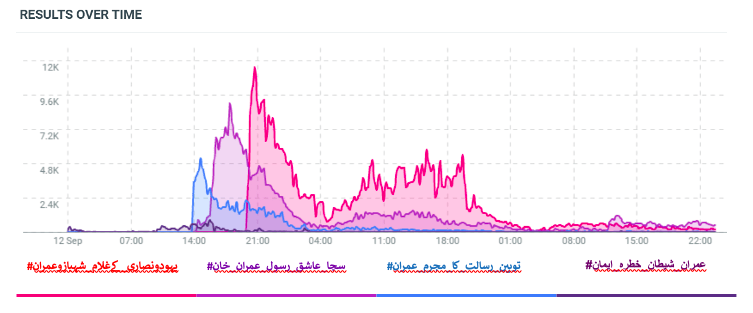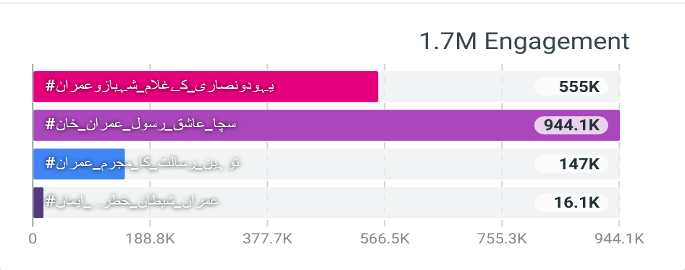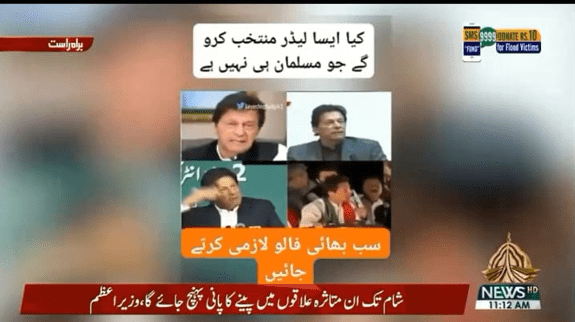September 20, 2022
ISLAMABAD – Over the last decade or so, Twitter has taken a central role in Pakistan’s political landscape, with the platform serving as a space where people from all walks of life — at least those who are able to read and have steady internet connections — come out to debate various topics and argue their points of view.
Despite being one of the least popular social media platforms in Pakistan, Twitter has become one of the most influential spaces for political discourse, with its trends reflecting the ever-changing mood of our society. But sometimes, it becomes an almost comical game of one-upping, mic dropping and thunder-stealing.
The events of last week, in particular, took this racket to near farcical proportions, with a new political game afoot: Who’s the better Muslim?
Holier than thou
Tuesday alone featured three top trends on the national panel, all dedicated to proving who deserved Pakistan because they were the ‘better Muslim’, who was a ‘traitor’, who had betrayed Pakistan, and so on.
The first trend #توہین_رسالت_کا_مجرم_عمران began at around 1:30 pm on September 12, with hundreds of tweets calling out PTI chief Imran Khan for his allegedly ‘blasphemous’ statements. Within an hour, the hashtag was trending at the top on Pakistan’s Twitter ecosystem, thanks in part to the PML-N’s social media teams and tweets from the Information Minister Marriyum Aurangzeb and Maryam Nawaz ramping up the Fitna Khan rhetoric.
Another 15 minutes, the PTI followed up with their own hashtag #سچا_عاشق_رسول_عمران_خان, which also quickly moved to the top trends of the day. The hashtag was accompanied by text reasserting that Imran Khan was not only a lover of Islam, but also a champion of religious rights and a defender of namoos-e-risalat. The latter claim was at times accompanied by videos of his speech at the UNGA, in which he had cautioned against the rising tide of Islamophobia around the world and called upon the United Nations to play its part in combatting religious hatred.
But it didn’t end here.
An hour after the PTI campaign started, the Tehreek-e-Labbaik Pakistan (TLP) joined in the fray, coming with its own hashtag #یہودونصاری_کےغلام_شہبازوعمران, which generated major activity throughout the night and into the next day, and even became one of the top 10 trends worldwide for a short period of time.
What followed is unsurprising — Pakistani Twitter was abuzz with claims that the government and the PTI are traitors to the cause of Pakistan and Islam, and that it was only the TLP that was the true harbinger of religious sanctity.
Somewhere, while the big boys were fighting, some accounts started sharing another hashtag that became a noteworthy trend temporarily, but continued in the same sentiment: #عمران_شیطان_خطرہ_ایمان. Clearly some users wanted to share the spoils.
Who can shout the loudest
Using open source intelligence (OSINT) tools, I conducted a mapping analysis of the four trends and separated them by colour code as is labelled below. As can be seen, the trends followed one after another within minutes or hours of each other, and dropped dramatically as soon as they reached their peak.
This shows engineered trending, meaning they weren’t genuine trends, but rather manufactured for point scoring and generating biased discussions to debase political personalities along religious lines on social media. This has become increasingly commonplace, but even by Pakistani standards, four hashtags all playing up the religion card at the same time is rare.

Further analysis shows that of the 840,000 tweets or posts, the TLP trend comprised nearly 50 per cent, meaning more deliberate activity by their social media team. However, in terms of performance, the PTI trend had far more engagements than all of the hashtags put together.
This clearly shows that while all the trends may have had an engineered component to them, the PTI trend generated more organic discussion. Given how popular the PTI and its chief are online, it is a testament to the level of digital activism their support base engages in.


However this ugly battle did not just end with the trends dying down. The PTI has since filed a lawsuit against Maryam Nawaz for accusing him of blasphemy.
In return, the PMLN pulled another card from the same deck, with Federal Minister Javed Latif addressing a press conference, doubling down on the Fitna Khan bandwagon, this time accusing Imran of supporting the Ahmeddiya community, and even urging the Federal Shariat Court to take suo moto notice of the PTI chief’s remarks which he claimed were “negating Islamic teachings”.
Railways Minister Khawaja Saad Rafique doubled down on the hate speech against the minority community in a tweet on Sunday.
It got even dirtier when the state television ran stories on the matter, taking selective clips of Imran’s words to make it look like he had said some religiously incendiary statements.

Obviously, the PTI is right to see this as appalling. On the other hand, the party itself has made it a point to use the religion card to its own benefit — Imran Khan has multiple times equated his political struggle to a jihad against his opponents. Even the use of the Quranic injunction to enjoin right and forbid wrong, Amr bil Ma’ruf wa Nahy an al Munkar, for the party’s protest campaigns was done to show that the PTI was not fighting a political battle, but a battle of good over evil.
Same tactics, new medium
We’ve seen this playbook before. Jinnah was labelled Kafir-e-Azam by the hard right. Zia used Nizam-e-Mustafa to ascend to power. The anti-PPP alliance spread photoshopped nude photos of Benazir Bhutto to prove to the public that she was unfit to rule because she was not a ’pure Muslim.
But what is happening now is different. Politicians have begun taking more and more extreme positions, and it is actually working.
The Barelvi extreme right used the hanging of Mumtaz Qadri to launch the TLP and run riot. PTI leaders use the Namoos-e-Risalat and Riyasat-e-Madina imagery in their campaigns, making it a point to highlight the party’s stance against Islamophobia and in a bid to outdo other parties’ rhetoric.
Meanwhile, PML-N leaders have escaped assassination attempts from those accusing them of supporting blasphemous practices, all due to the vitriol laid out against them. And yet, they continue to use the same vitriol every chance they get.
It is no longer enough to be a politician. You have to prove yourself to be a true God-fearing Muslim. Tasbeeh included.
It is no longer enough to defeat a political opponent. They must be labelled as evil incarnate.
Terms like fitna and jihad don’t belong in political vocabulary, but with militant groups. We are seeing the extreme and the mainstream overlap. Politics is devolving in an ugly fashion, using an ‘ends justifies the means’ approach.
The hashtags created this week are not outliers. They are a symptom of a disease getting worse. We are seeing in real time the mainstreaming of religious extremism in our politics. They may have begun for scoring cheap political points, but they are creating a fertile ground for radicalisation in our society.
As witnessed over the years, once the wheels start turning, they’re not going to stop. Politicians will have to take more and more radical positions as a way to appease their base and stay legitimate. But history has shown us time and again that appeasement doesn’t work. It just lays the ground for more polemics.
Over time, we may see no difference between the zeal of these parties and the objectives of the militants. We may well see groups like the TTP becoming part of the political mainstream, since their goals won’t be too different from the other major parties, all contributing to the detriment of society as a whole. We already have precedents of violent proscribed groups such as the TLP and SSP being allowed to do so, so this isn’t really that off the cards.
Rather than seeing what is being gained, these parties must consider the cost of these tactics, and how damaging it will be to society in the long run.
The game of Who is the Better Muslim needs to end. Unless it does soon, it will turn into a trans-generational shift towards extremism and violence, the likes of which we have not seen before.


